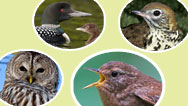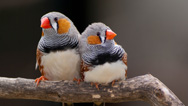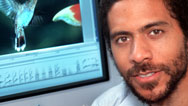Bird Brains
- Posted 07.16.08
- NOVA scienceNOW
(This video is no longer available for streaming.) Birds have an undeserved reputation for low brainpower. In fact, they produce one of the most glorious phenomena in nature: birdsong. How do their brains do it? And what does this skill tell us about the evolution of another remarkable phenomenon, human language?
Research on an Australian songbird called the zebra finch is shedding light on babbling in babies, stuttering, and the neuronal processes of understanding and making sounds. Evidence of the evolution of birdsong as well as human speech may lie in our genes, including an intriguing gene called FOXP2.
Transcript
BIRD BRAINS
PBS Airdate: July 16, 2008
NEIL DeGRASSE TYSON: Hello, I'm Neil deGrasse Tyson, your host of NOVA scienceNOW. You know, the ability to speak is one of those things that makes us humans think we're special.
EINSTEIN (Parrot): Special.
NEIL DeGRASSE TYSON: But researchers have struggled to figure out exactly how we got this talent.
EINSTEIN: Talent.
NEIL DeGRASSE TYSON: Because learning to speak a language takes a lot more than just mindlessly parroting what someone else says.
EINSTEIN: Mindless.
NEIL DeGRASSE TYSON: Now, as correspondent Chad Cohen reports, we're finding new clues in the brains of some animals, who have the language ability to even rival our own.
EINSTEIN: Split infinitive!
CHAD COHEN: It's a skill that comes naturally to even the tiniest among us. We take in sounds, repeat them and learn to talk. We're so good at it, we can even do it in more than one language, like these little New Yorkers, who are learning French even before they've mastered English. And yet we still don't understand how.
It's a mystery scientists are starting to unravel by studying a brain about 1,000 times smaller than our own, a brain that's gotten a really bad rap.
If someone calls you a birdbrain how would you feel?
OFER TCHERNICHOVSKI: Oh, a great compliment! The bird brain is a very good brain.
CHAD COHEN: Ofer Tchernichovski, one of the world's leading experts in birdsong, thinks the term "birdbrain" is a real misnomer. In fact he believes the key to solving the mystery of speech lies in the notes of a bird's song.
OFER TCHERNICHOVSKI: By looking at the song and see how the song develop, you can understand, sometimes, very basic principles of how our brain works and how our mind works.
CHAD COHEN: In his lab, Ofer studies an Australian songbird called a zebra finch.
OFER TCHERNICHOVSKI: Now you can actually see them side by side.
CHAD COHEN: It turns out, this tiny bird learns to sing much like we learn to speak.
OFER TCHERNICHOVSKI: In the beginning, the bird will start singing a very faint, unstructured song, similar to babbling in human infants.
CHAD COHEN: It then starts to mimic the sounds it hears from the adults around it, a lot like we do.
MOM Can you say ham? See the ham?
BABY: Ham.
OFER TCHERNICHOVSKI: So birds are vocal learners, and vocal learning is very rare in nature.
CHAD COHEN: While zebra finches learn only one song, other songbirds, like canaries, can learn new songs seasonally. Some hummingbirds learn songs more bug-like then bird-like. And parrots, like this one named Einstein...
EINSTEIN: Hello.
CHAD COHEN: ...can even mimic other species...
EINTSTEIN'S TRAINER: Can you do a pig?
EINSTEIN: Oink, oink, oink, oink.
CHAD COHEN: ...adding new words to their repertoire all the time.
TRAINER: What does everyone say in Tennessee?
EINSTEIN: Yahoo!
CHAD COHEN: Einstein seems content to receive a treat for displaying his vocal talents. In the wild though, male songbirds use their song to defend territory or to woo a mate. The guy with the best song gets the girl, but to get her, he's got to be creative...
OFER TCHERNICHOVSKI: Every individual bird has his own song, has his own performance, so they imitate, but they also diverge and vary.
CHAD COHEN: ..and in the process, create rather sophisticated melodies.
OFER TCHERNICHOVSKI: So here is a song of a veery. Let's listen to it a little. Does it sound musical to you?
CHAD COHEN: It sounds like a bird.
OFER TCHERNICHOVSKI: Now I'll slow it down for you.
CHAD COHEN: That's incredible. That's incredible. That's the same bird?
Birdsong is so elegant it's inspired the great masters. Mozart borrowed these notes from his beloved starling. When his muse died, the distraught maestro even gave it a formal funeral and wrote a poem in its honor.
OFER TCHERNICHOVSKI: Let me play you something and see if it reminds you of a piece of music. So here is a wood wren song.
CHAD COHEN: So, that's Beethoven's Fifth out of the mouth of a wood wren. That's just crazy. That's just crazy.
OFER TCHERNICHOVSKI: Beethoven was really a fraud, uh?
CHAD COHEN: Yeah. So which came first, though?
OFER TCHERNICHOVSKI: He came first, I can tell you that, at least a few thousand years earlier.
CHAD COHEN: Duke University neurologist Erich Jarvis thinks we have a lot more in common with songbirds than first meets the ear. He's been studying bird brains and comparing them with ours.
ERICH JARVIS (Neurobiologist, Duke University): The basic similarity between songbirds and humans is that we both have cerebral brain areas that control learned vocal behavior.
CHAD COHEN: So, if you look at the cerebral areas of my brain, for example, this area back here helps me understand the words I hear. Whereas, a little bit further up, this area helps me produce the actual words. It's taking no less then 100 muscles, by the way, just for me to be telling you this. And before I can utter a single word, that word-understanding area and that word-producing area need to talk to each other through some sophisticated circuitry.
A songbird's brain also has areas that process and produce sound, and these areas are also connected through sophisticated circuitry.
JUAN URIAGEREKA: For an organism that is so distant from us, that's quite remarkable. Nature is playing a very slick trick, right there.
CHAD COHEN: A trick that Dr. Santosh Helekar is using to help unravel the mystery of speech. He's exploring a troubling speech disorder...
DENNIS: I love to, to, to, to, to, to...
CHAD COHEN: ...stuttering, a condition that causes patients, like Dennis, to get stuck on syllables. Believe it or not, Santosh thinks that some of his zebra finches have a similar problem. Yep, it appears songbirds stutter, too.
SANTOSH HELEKAR (Baylor College of Medicine): A normal birdsong of a zebra finch consists of a sequence of syllables that are repeated over and over again.
CHAD COHEN: This is the sonogram of a normal zebra finch song. A simple melody, consisting of several syllables repeated over and over again. But Santosh's stuttering birds sing like this.
They get stuck on one syllable and keep repeating it over and over again, not unlike what's happening to Dennis.
HENNING VOSS: Hi, Santosh. How are you?
SANTOSH HELEKAR: Hi, Henning. How are you? I brought some birds.
CHAD COHEN: To find out why, Santosh, along with colleague Henning Voss of the Weill Medical College of Cornell, decide to scan the brains of these pint-size stutterers.
To do it, they have to adapt an fMRI machine, designed for a human brain, to scan one a lot smaller. Henning creates this coil to do the job.
Once the tiny patient is mildly sedated, it's put inside the coil and into a soundproof box, equipped with headphones. Then bird, box and all, are placed into the fMRI and the scanning begins.
HENNING VOSS: We will see the brain from the side.
CHAD COHEN: They soon pick up a signal.
HENNING VOSS: This is the forebrain, the cerebellum. Here, one can see midbrain and spinal cord coming out, and the beak.
CHAD COHEN: Now it's time for the entertainment portion of our program.
The tiny patient is played a familiar melody, the song of its father, who first taught him how to sing.
As it listens, the scanner picks up increased blood flow in the part of the brain used to process sound.
HENNING VOSS: Okay, we have very nice activations...
SANTOSH HELEKAR: ...smack in the middle of the hearing center of the brain.
CHAD COHEN: The scans show nice activation, but when they compare the results of these stuttering birds with scans of normal birds, they find a difference.
SANTOSH HELEKAR: A stuttering bird's brain doesn't have the same pronounced activation as a normal bird has.
CHAD COHEN: And here's where it gets really interesting. It turns out, similar activation patterns are found in human stutterers. Stutterers have less activity in an area of the brain used to process sound than normal speakers do.
This connection between human brains and bird brains poses yet another question for researchers: how did two distinctly different species end up with, not only intriguingly similar vocal learning systems, but similar speech disorders? The answer may lie in our genes.
Back in the 1990s, researchers found a genetic link to language, when they discovered an English family suffering from a rare speech disorder.
INTERVIEWER: Where do you live Laura?
LAURA: (inaudible)
ROBERT C. BERWICK (Massachusetts Institute of Technology): This family had extreme difficulty with vocalization, moving their mouths around the right way, with putting the sounds in the right order.
CHAD COHEN: Genetic studies revealed a single gene mutation was the cause. The faulty gene, called FOXP2, was christened "the language gene."
ERICH JARVIS: That discovery prompted myself and Constance Scharff, a long time collaborator of mine, to examine whether or not something was similar in songbirds.
CONSTANCE SCHARFF (Free University of Berlin): Do birds have the FOXP2 gene? Because that wasn't clear at the time.
CHAD COHEN: Well, they not only found the FOXP2 gene in birds, they discovered how it influences the way a bird learns to sing.
ERICH JARVIS: When the young birds are learning how to imitate songs, the FOXP2 gene was going up.
CHAD COHEN: This enabled cells to produce more protein.
ERICH JARVIS: And after learning was complete, it went down. Not only that, we found that in canaries, who can continue to learn song throughout life, at the time of the year they're learning to imitate new songs, the FOXP2 gene goes up again.
CHAD COHEN: An amazing discovery that brings with it a whole other set of questions. FOXP2 is found in just about everything from fish to yeast.
CONSTANCE SCHARFF: Even in flies and bees. So it's not the gene that makes us speak. It's a gene that is being used in many neighborhoods.
CHAD COHEN: Erich Jarvis, for one, is committed to figuring this out. He's set his sights on identifying other genes that may hold the key to why we can speak, birds can sing and others, even our closest relatives, cannot.
It's not for lack of communication skills. Since the 1970s, researchers have demonstrated that chimps understand our words and can even answer back.
ERICH JARVIS: Chimps have this ability of sign language. They already have language with the hands, they just can't do it with the voice.
CHAD COHEN: Jarvis theorizes that a few unknown genes give us something the chimps don't have, that neural circuitry connecting the word-understanding area of our brain to the word-producing area. Without this circuitry, he surmises, chimps can't speak.
ERICH JARVIS: It's not such a crazy idea to think that a few genes have to be mutated to get such a system in the brain.
CHAD COHEN: A system that gives us the gift of gab and our feathered friends inspiring melodies.
JUAN URIAGEREKA: I love these little guys, but now doubly so, because they're a model organism. We can seriously study them.
CHAD COHEN: Whether it's through words or song, one thing's for certain. We aren't the only ones with something to say.
TRAINER: How about a chimpanzee.
EINSTEIN: Ooh, ooh, ooh, ooh, ah, ah.
Credits
Bird Brains
- Edited by
- Jedd Ehrmann
- Produced and Directed by
- Terri Randall
NOVA scienceNOW
- Executive Producer
- Samuel Fine
- Executive Editor
- Neil deGrasse Tyson
- Senior Series Producer
- Vincent Liota
- Supervising Producers
- Stephen Sweigart
Joey David - Editorial Producer
- Julia Cort
- Development Producer
- Vinita Mehta
- Senior Editor
- David Chmura
- Online Editor
- Laura Raimondo
- Series Production Assistant
- Fran Laks
- Assistant Editors
- Susan Perla
Tung-Jen (Sunny) Chiang - Compositors
- Brian Edgerton
Yunsik Noh - Music
- Rob Morsberger
- NOVA scienceNOW series animation
- Edgeworx
- Associate Producers
- Cully Gallagher
John Goebel
Daniel Sites
Anna Lee Strachan - Camera
- John Chater
Austin de Besche
Brian Dowley
Joseph Friedman
Michael Phillips - Sound Recordists
- Ray Day
Lee Frank
Lisa Johnson
Charlie Macarone
Myron Partman - Sound Mix
- David Chmura
- Animation
- FIGG Bridge Engineers, Inc.
Anthony Kraus
David Margolies
Sputnik Animation
James LaPlante
Adam Tow - Production Assistants
- Mona Damluji
Nadira Ilana
Drew Grimes
Elizabeth Stachow - For Lone Wolf Documentary Group
- Executive Producer
- Kirk Wolfinger
- Production Manager
- Donna Huttemann
- For Twin Cities Public Television
- Executive Producer
- Richard Hudson
- Managing producer
- Lynn Winter
- Archival Material
- Federal Emergency Management Agency
Getty
Internet Moving Images Archive
ITN
Ville Karvinen
Knoxville Zoo
Jan Karel Lameer
The Macaulay Library at the Cornell Lab of Ornithology
NASA
Penn State University Archives, Pennsylvania State University Libraries
Luc de Nil
WCCO-TV - Special Thanks
- Simon Baker
Aleksander Chernucho
Dennis Kavlakoglu
Libby Lewis Photography
The Methodist Neurological Institute
Museum of Science and Industry
New York Presbyterian Hospital, the University Hospital of Columbia and Cornell and Citigroup Biomedical Imaging Center
Ian Ryan
Phil Schneider
Sahar Salem
Veronica Smith
Francois Thibaut and The Language Workshop for Children
Waite House - Neil deGrasse Tyson
- is director of the Hayden Planetarium in the Rose Center for Earth and Space at the American Museum of Natural History.
- NOVA scienceNOW Consortium Stations
- Nebraska Educational Telecommunications, NET
Public Broadcasting for Northern California, KQED
Twin Cities Public Television, TPT
Wisconsin Public Television, WPT - NOVA Series Graphics
- yU + co.
- NOVA Theme Music
- Walter Werzowa
John Luker
Musikvergnuegen, Inc. - Additional NOVA Theme Music
- Ray Loring
Rob Morsberger - Post Production Online Editor
- Spencer Gentry
- Closed Captioning
- The Caption Center
- Publicity
- Carole McFall
Eileen Campion
Lindsay de la Rigaudiere
Victoria Louie
Kate Becker - Senior researcher
- Gaia Remerowski
- Production Coordinator
- Linda Callahan
- Paralegals
- Raphael Nemes
Sarah Erlandson - Talent Relations
- Scott Kardel, Esq.
Janice Flood - Legal Counsel
- Susan Rosen
- Post Production Assistant
- Darcy Forlenza
- Associate Producer, Post Production
- Patrick Carey
- Post Production Supervisor
- Regina O'Toole
- Post Production Editors
- Rebecca Nieto
Alex Kreuter - Post Production Manager
- Nathan Gunner
- Compliance Manager
- Linzy Emery
- Business Manager
- Joseph P. Tracy
- Producers, Special Projects
- Lisa Mirowitz
David Condon - Coordinating Producer
- Laurie Cahalane
- Senior Science Editor
- Evan Hadingham
- Senior Series Producer
- Melanie Wallace
- Managing Director
- Alan Ritsko
- Senior Executive Producer
- Paula S. Apsell
This material is based upon work supported by the National Science Foundation under Grant No. 0638931. Any opinions, findings, and conclusions or recommendations expressed in this material are those of the author(s) and do not necessarily reflect the views of the National Science Foundation.
NOVA scienceNOW is a trademark of the WGBH Educational Foundation
NOVA scienceNOW is produced for WGBH/Boston by NOVA
© 2008 WGBH Educational Foundation
All rights reserved
- Image credit: (finch) © Eric Isselée/iStockphoto
Participants
- Robert Berwick
- Massachusetts Institute of Technology web.mit.edu/bcs/people/berwick.shtml
- Chad Cohen
- Correspondent
- Santosh Helekar
- Baylor College of Medicine
- Erich Jarvis
- Neurobiologist, Duke University
- Constance Scharff
- Free University Berlin www.biologie.fu-berlin.de/en/verhaltensbiologie/team/scharff/index.html
- Ofer Tchernichovski
- The City College of New York www1.ccny.cuny.edu/current/SURIC/mentors/Professor-Ofer-Tchernichovski.cfm
- Juan Uriagereka
- University of Maryland www.ling.umd.edu/~juan/
Related Links
-

Name That (Bird) Tune
Match eight different songs and calls to the correct birds, and learn how they master such precise pitch and phrasing.
-

Bird Brains: Expert Q&A
Ofer Tchernichovski, who studies bird brains and vocal learning at the City College of New York, answers questions.
-

Songbirds as Clues to Creativity
The way birds construct their songs could give us insight into the nature of creativity and the learning process.
-

Profile: Erich Jarvis
Neuroscientist Erich Jarvis, who trained as a dancer, has helped transform our understanding of bird intelligence.



